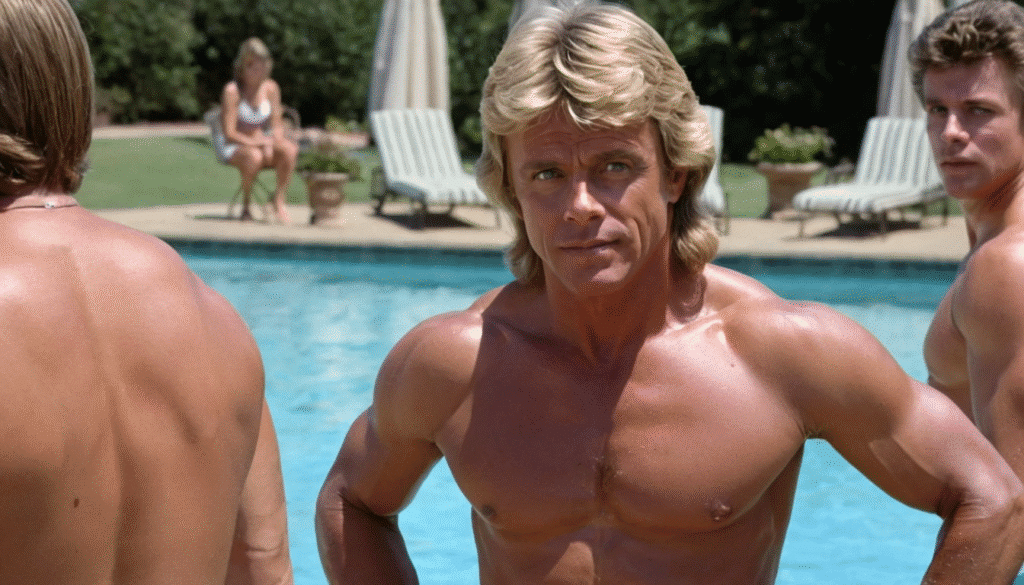Christopher Atkins Stuffing Speedo Iconic 80s TV, Humor, and Celebrity Reality
The phrase “Christopher Atkins stuffing Speedo” has become a pop culture legend, symbolizing the lighter (and cheekier) side of television’s golden era.
This story isn’t just about a wardrobe quirk on Dallas, but a window into how male body image, TV censorship, and celebrity confidence shaped the 1980s entertainment landscape.
When Atkins, already an international heartthrob from The Blue Lagoon, joined Dallas as Peter Richards, his swimwear sparked more headlines than plot twists. Recently, Atkins revealed he was “reprimanded” by CBS producers for allegedly “stuffing” his Speedo, turning a minor behind-the-scenes moment into an enduring part of Hollywood folklore.
If you love celebrity scandals, 80s nostalgia, or the social context of TV fashion, this deep-dive is for you.
For more on iconic TV moments, check out this classic scandals guide, celebrity pop culture breakdown, and TV’s most famous wardrobe stories.
Find further reading at body image issues in Hollywood, television’s changing standards, and celebrities who challenged norms.
Key Points:
- “Christopher Atkins stuffing Speedo” is a case study in how small TV moments become cultural talking points.
- This article delivers deep analysis, cultural context, and trusted sources for 80s TV history fans.
1. Christopher Atkins: From The Blue Lagoon to Dallas Sensation
Christopher Atkins’ Hollywood story is anything but ordinary. Debuting in 1980’s The Blue Lagoon at just 18, Atkins became a household name for his daring nude scenes and youthful innocence. His image as a sex symbol was cemented overnight, and directors quickly took notice of his comfort with bold, revealing roles.
By 1983, Atkins landed the role of Peter Richards on the legendary series Dallas—one of the most-watched shows of all time. As a young camp counselor entangled with the Ewing family, his character’s presence (and physique) immediately drew attention. The infamous Speedo scenes, meant to highlight athleticism and confidence, soon became a topic of backstage humor and tabloid interest.
Key Points:
- Atkins’ comfort with bold roles began in The Blue Lagoon and carried into Dallas.
- His reputation as a sex symbol both helped and challenged his acting career.
2. The CBS Reprimand: Fact, Humor, and Industry Context
The central incident—the CBS “reprimand” for stuffing his Speedo—is both humorous and telling about 80s entertainment norms.
Atkins described the moment with good-natured humor. After appearing in a Speedo for several scenes, he received a producer note:
“Please stop stuffing my Speedo.”
Atkins responded, “Hell no!”—treating it as a backhanded compliment rather than criticism. He has repeatedly clarified in interviews that he never stuffed his swimwear, and that the whole affair was more about playful teasing among cast and crew.
But there’s a bigger story here:
TV producers in the 1980s were navigating strict broadcast standards. Dallas, known for pushing boundaries, had to balance suggestiveness with what network censors would approve. Even small details like swimwear could spark nervous jokes—and network notes.
Key Points:
- The “reprimand” was a mix of humor and genuine concern over TV standards.
- Atkins’ confidence and playful response set a positive tone on set.
3. Body Image and the Male Gaze: Double Standards in TV
Most celebrity wardrobe controversies focus on female stars, but the “Christopher Atkins stuffing Speedo” moment reminds us that male bodies were also objectified, scrutinized, and commodified by producers and the public.
Atkins’ situation exposes a double standard:
Just as actresses faced pressure to look a certain way, male actors like Atkins were expected to maintain peak physical shape and be comfortable with on-screen exposure. For many, this attention brought both opportunity and anxiety. Even playful rumors about “stuffing” speak to the larger issue of how body image—male or female—was used to sell stories and create buzz.
This topic is still relevant, as recent studies on male body image in media highlight how unrealistic expectations affect confidence and mental health for stars and fans alike.
Key Points:
- The Speedo scandal highlights that male actors, too, face unrealistic body standards.
- Hollywood’s double standards around body image continue to spark debate today.
Christopher Atkins in 80s Swimwear

4. Humor on Set: Turning Scandal Into Inside Joke
What makes this story so enduring is Atkins’ reaction. Instead of embarrassment, he laughed it off and made it part of Dallas legend. In interviews, he recounts how the crew found the situation amusing, and how the note from CBS became an ongoing inside joke.
This positive, confident response matters. In an era where “scandal” could quickly destroy a star’s image, Atkins’ sense of humor turned the controversy into a badge of honor. He has said in multiple interviews, including one with PageSix, that he took the note as a compliment on his physique rather than a criticism.
Key Points:
- Atkins turned potential scandal into a positive, lighthearted story.
- His humor set the tone for a healthy, supportive environment on set.
5. Media Coverage, Tabloids, and Public Fascination
The “Christopher Atkins stuffing Speedo” anecdote lives on because it blends humor, innocence, and the public’s endless curiosity about what happens behind the scenes.
Tabloids quickly picked up the story—headlines appeared everywhere from People Magazine to OK! Magazine.
Why do stories like this go viral?
Simple: they combine nostalgia, sex appeal, humor, and a touch of rebellion—all key ingredients for media buzz. As Atkins himself jokes, “there’d be a day they’d pay me to keep my clothes on.” His playful embrace of the story only added to its appeal.
For similar cases, visit TV’s most memorable controversies, celebrity wardrobe slip-ups, and pop culture icons revisited.
Key Points:
- Media fascination with scandal keeps such stories alive for decades.
- Atkins’ attitude turned a minor incident into pop culture history.
Image: Iconic Dallas Poolside Scene

6. Broader Lessons: Agency, Empowerment, and TV’s Evolving Standards
The story isn’t just a joke—it also raises serious questions about agency and empowerment.
Atkins’ willingness to control the narrative—owning the moment, using humor, and refusing to be shamed—provides a model for public figures everywhere. It demonstrates how celebrities can challenge the media, push back against scrutiny, and define their own legacy.
Meanwhile, TV standards have changed dramatically. What was controversial in 1983 might seem tame today, but the core issues—consent, agency, and respect—are more relevant than ever.
For more on evolving media standards, check out changing TV rules, celebrity empowerment in media, and role models in pop culture.
Key Points:
- Controlling your narrative is a powerful tool against scandal and rumor.
- TV’s changing standards show society’s evolving values around body image and humor.
7. What Happened Next: Christopher Atkins’ Career and Reflections
After Dallas, Atkins continued acting, modeling (including a now-legendary Playgirl spread), and later embraced a quieter life in Connecticut, focusing on family and occasional public appearances.
He looks back on his career—and Speedo saga—with amusement and pride, seeing it as just one memorable moment among many.
The story has taken on a life of its own, often cited as a humorous example of how Hollywood—and its stars—handled fame, scandal, and body image. It stands as a lesson in resilience, self-deprecating humor, and staying true to yourself, no matter what headlines say.
Key Points:
- Atkins’ post-Dallas life is defined by balance, confidence, and reflection.
- The Speedo anecdote remains a highlight of his Hollywood story.
Video: Christopher Atkins Remembers The Speedo Scandal
Conclusion: The Enduring Legacy of Christopher Atkins’ Speedo
The “Christopher Atkins stuffing Speedo” story is more than just a funny Hollywood anecdote. It captures an era when TV pushed boundaries, body image was scrutinized, and celebrities were learning to navigate fame, scandal, and personal agency.
Atkins’ humor, confidence, and refusal to let a silly rumor define him offer a lasting lesson for anyone in the public eye—or anyone facing judgment, online or off.
His story reminds us: be confident, own your narrative, and above all, never let a Speedo (or a rumor) steal your smile.
For deeper analysis, explore celebrity resilience in pop culture, TV scandal retrospectives, and empowering celebrity stories.
Key Points:
(FAQS) – Christopher Atkins Stuffing Speedo
1. Did Christopher Atkins really stuff his Speedo on Dallas?
No, Christopher Atkins has always denied intentionally stuffing his Speedo. The rumor began as an on-set joke and a playful note from producers, not a real scandal.
2. How did Atkins respond to the CBS note?
He laughed it off, saying “Hell no!” and has said in interviews that he took the comment as a compliment rather than criticism.
3. Did the Speedo controversy impact his career?
Not negatively—if anything, it added to his legend as a sex symbol and showcased his confidence and good humor.
4. Are there similar scandals in TV history?
Yes, both male and female stars have faced wardrobe controversies. What stands out is how they handle them—Atkins’ story is a model for positivity.
5. Where is Christopher Atkins now?
He lives in Connecticut, enjoying family life and occasional interviews, still remembered for his iconic 80s roles and playful approach to fame.
People Also Ask (PAA)
Q1: Why was Christopher Atkins’ Speedo scene controversial?
Because TV in the 1980s had strict censorship and body image standards. Any suggestive scene—especially involving revealing swimwear—was closely monitored by producers and often became headline news.
Q2: How did fans react to the Speedo rumor?
Most fans embraced the story with humor, seeing it as part of Atkins’ cheeky, confident persona. The story actually enhanced his popularity.
Q3: Was body image pressure unique to female stars?
No, male stars like Atkins faced their own pressures—especially those known for athletic or “sex symbol” roles. The Speedo story highlights how men, too, were judged by appearance.
Q4: Do such controversies still happen today?
Yes, but the social media era amplifies everything. What might have been an inside joke in the 80s can now go viral worldwide within minutes.
Q5: Did Atkins’ Playgirl spread influence the Dallas Speedo jokes?
His modeling career, especially the Playgirl spread, reinforced his sex symbol image. It likely added to the playful speculation around his Dallas swimwear.
Q6: What lessons does this story offer for today’s stars?
Control your narrative, use humor, and don’t let rumors define your legacy. Confidence and authenticity win out over scandal every time.
- Christopher Atkins’ Speedo story combines nostalgia, confidence, and lessons in media savvy.
- His approach to scandal is a model for celebrities—and fans—navigating the ups and downs of public life.




2 thoughts on “Christopher Atkins Stuffing Speedo: 7 Revealing Facts Confidence and Controversy in 80s TV”